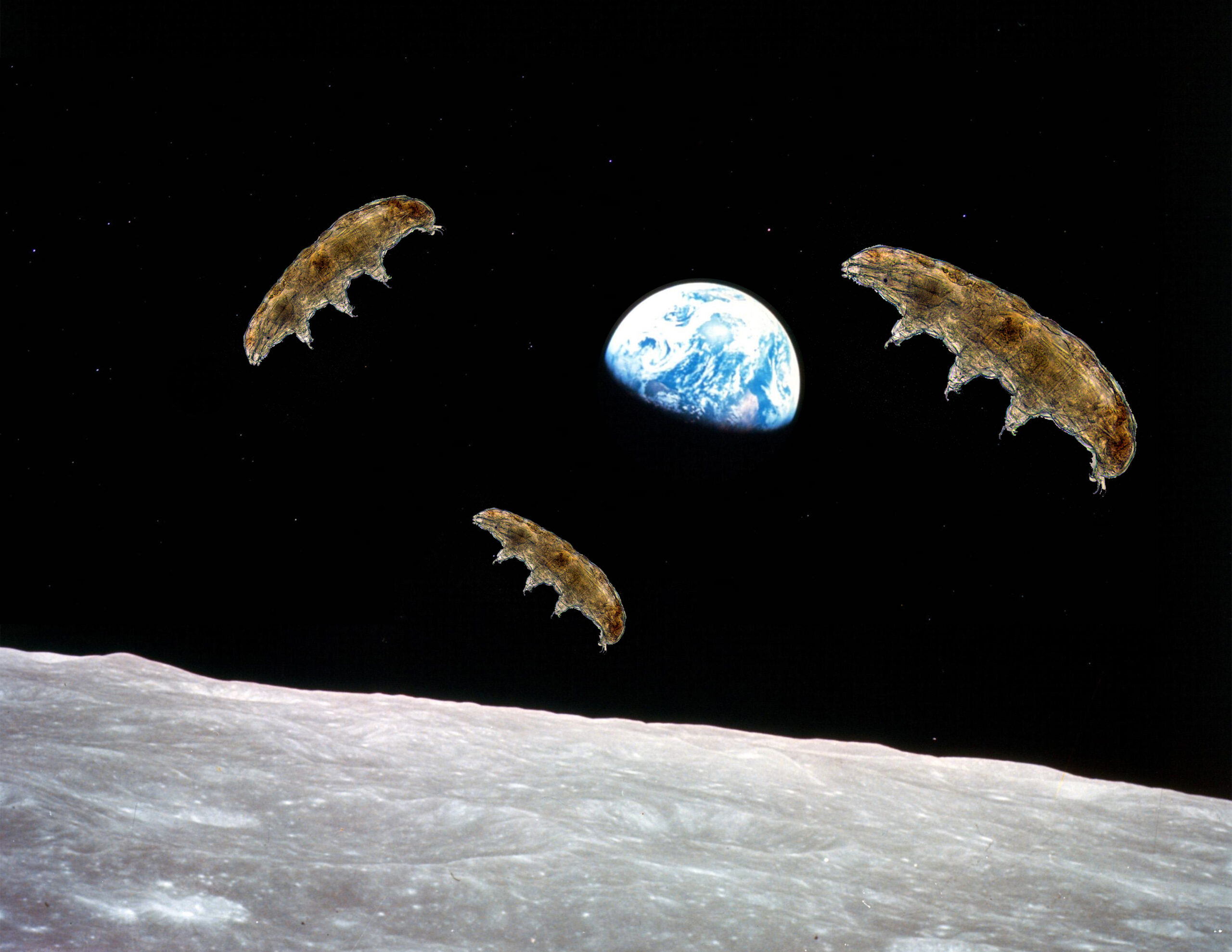Tardigrades Are Now in Space! I Repeat, Tardigrades Are Now in Space

The SpaceX resupply of the International Space Station on June 3rd carried some very special guests: thousands of tardigrades. The near-microscopic, strangely adorable, and wildly resilient creatures that resemble swimming bears are now hanging out on the ISS. NASA is hoping tardigrades will be able to teach us a thing or two about surviving in extreme conditions.
I first saw the news on one of my favorite Twitter accounts, @tardigradopedia, a great source for all things about the wee beings. Tardigrades fascinate many, and have a considerable fan base beyond the reach of most micro-animals, for a few reasons. First and foremost there’s that “water bear” element (they are also known as “moss piglets,” which might be an even cuter name). The water bear name came from German Zoologist
Johann August Ephraim Goeze in 1773, who called them “kleiner Wasserbär,” or “little water bear.”
✨ . * . 🪐 .
. . . .
* . ☄️
* . 🚀 . . https://t.co/UUZy5dd6r0— Tardigradopedia (@tardigradopedia) May 30, 2021
Water bears are headed to space today!! They can survive extremely harsh environments. Studying them and how they adapt to these environments might help us understand the stress factors affecting humans in space 🤯 @ISS_Research pic.twitter.com/dcJvaC8ILQ
— Camille Calibeo (@TheGalacticGal) June 3, 2021
We can’t help viewing tardigrades and seeing their resemblance to much larger animals, while at the same time they are distinct and already live in an “alien” world—far away under a microscope. Then once you start reading about tardigrades, the fascination ramps up, because these guys are resilient. Hugely resilient.
STOP MESSING WITH THE TARDIGRADES. One day they’re going to get sick of our clowning and they can’t be killed.https://t.co/jkJ2T6Wo07
— Ali Davis 🏳️🌈 (@Ali_Davis) May 28, 2021
Found everywhere on Earth, from rainforests to the Antarctic, “individual species [are] able to survive extreme conditions—such as exposure to extreme temperatures, extreme pressures (both high and low), air deprivation, radiation, dehydration, and starvation—that would quickly kill most other known forms of life,” Wikipedia tells us. Water bears have been exposed to space before. But this time, they’re part of a specific study at the ISS that NASA hopes could lead to helping humans adapt to extreme conditions as well.
Thousands of water bears are on their way to the @Space_Station aboard a SpaceX Dragon capsule right now! After they arrive to station, researchers will study the microscopic creatures for clues that might help humans in space as well. https://t.co/QK8DRb2BiJ
— ISS Research (@ISS_Research) June 4, 2021
Piglets in space! Today #tardigrades (aka ‘water bears’ 💦🐻 or ‘moss piglets’🌱🐷) of the genus that inhabits #Antarctic soil headed to the #InternationalSpaceStation, in a #science experiment aiming to identify their genes for #extreme survival.
More at https://t.co/rp5v4VShsZ pic.twitter.com/42hris7Cd2— antarctica.gov.au (@AusAntarctic) June 4, 2021
NASA has released more information about the tardigrades’ extraterrestrial adventure and what they’re hoping to discover.
Water bears take on space
Tardigrades, known as water bears due to their appearance under a microscope and common habitat in water, are tiny creatures that tolerate environments more extreme than most life forms can. That makes them a model organism for studying biological survival under extreme conditions on Earth and in space. In addition, researchers have sequenced the genome of the tardigrade Hypsibius exemplaris and developed methods for measuring how different environmental conditions affect tardigrade gene expression. Cell Science-04 characterizes the molecular biology of short-term and multigenerational survival of water bears, identifying the genes involved in adaptation and survival in high stress environments.
The results could advance understanding of the stress factors affecting humans in space and support development of countermeasures. “Spaceflight can be a really challenging environment for organisms, including humans, who have evolved to the conditions on Earth,” says principal investigator Thomas Boothby. “One of the things we are really keen to do is understand how tardigrades are surviving and reproducing in these environments and whether we can learn anything about the tricks that they are using and adapt them to safeguard astronauts.”
Those astronauts already hovering around in space are excited to greet the tardigrades.
I can’t wait to welcome water bears to the @Space_Station! They’ll be flying to station aboard the next @SpaceX commercial resupply launch, along with many other science experiments. https://t.co/a8C32Q0EiD pic.twitter.com/nnXeb0Qole
— Megan McArthur (@Astro_Megan) May 27, 2021
They sure were ferried there in style.
Tardigrades on board🚀✨ https://t.co/xbJviff9xA
— Tardigradopedia (@tardigradopedia) June 2, 2021
Seems like Star Trek: Discovery was indeed forecasting the future when they included a giant tardigrade-like being encountered in their own space explorations.
I can’t wait to see what NASA discovers about our watery friends. In the meantime, I will keep enjoying all of the prime tardigrade content that Twitter has to offer. Here is a very small recent sampling, courtesy of Tardigradopedia:
And meanwhile on the International Space Station pic.twitter.com/QtrYzE5tRF
— Tardigradopedia (@tardigradopedia) June 4, 2021
Aaaay…keep it cool#illustrationofthday #tardigrade #cool pic.twitter.com/LYnB40lBwB
— Nici Gregory (@NiciGregory) May 28, 2021
Tardigrades are notable for being the most resilient animal: they can go without pizza for more than 30 years pic.twitter.com/VKize3ApaO
— Tardigradopedia (@tardigradopedia) April 26, 2021
— Tardigradopedia (@tardigradopedia) May 28, 2021
We can even have tardigrade pride for Pride Month, as a treat.
I think I can find tardigrades, also known as waterbears or moss piglets, for each of the colours except (magenta/purple) and pink, unless I stain them! #Pride2021 @tardigradopedia @PridePolar @PrideinSTEM @BodenLab @PlymUni
— Dr Nigel J. Marley (@Nigel_Marley) June 1, 2021
(via Tardigradopedia on Twitter, images: screengrab from antarctica.gov.au, CBS All Access)
Want more stories like this? Become a subscriber and support the site!
—The Mary Sue has a strict comment policy that forbids, but is not limited to, personal insults toward anyone, hate speech, and trolling.—
Have a tip we should know? tips@themarysue.com